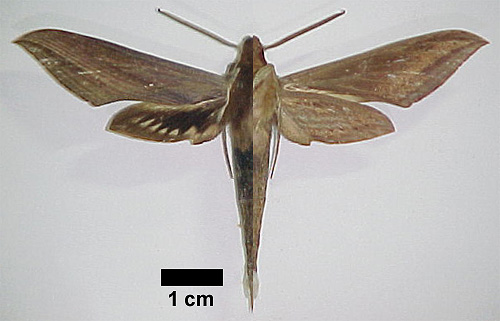Xylophanes eumedon
|
|
Updated as per CATE, December 2, 2008
|
Xylophanes fernandezi
Chacin, Clavijo, & De Marmels, 1996

Xylophanes fernandezi, Venezuela, from
Hawkmoths of Venezuela,
courtesy of Dr. María Esperanza Chacín
and José Clavijo A., Ph.D.
This site has been created by
Bill Oehlke at oehlkew@islandtelecom.com
Comments, suggestions and/or additional information are welcomed by Bill.
TAXONOMY:
Family: Sphingidae, Latreille, 1802
Subfamily: Macroglossinae, Harris, 1839
Tribe: Macroglossini, Harris, 1839
Genus: Xylophanes Hubner [1819] ...........
Species: fernandezi
|
MIDI MUSIC
.....It's a Wonderful World.....
copyright C. Odenkirk
ON.OFF
<bgsound src="world.mid" LOOP=FOREVER>
|
DISTRIBUTION:
Xylophanes fernandezi moths
(wingspan: approx 78 mm) fly in Venezuela (specimen type locality).
I believe the forewing length for males is 44-47mm.
"Similar to Xylophanes tersa tersa and Xylophanes resta but differs in its dark, monotonous appearance.
Head and thorax dorsally dark brown to brown-black. Dorsal scaling of antenna dirty white. Abdomen dorsally ash-brown with five dark longitudinal lines;
basal black patches present; laterally stripes paler rust-brown.
Forebasitarsus with outer row of spines. Tibiae externally white. Outer apical spur of hindtibia less than half as long as inner.
Forewing upperside ground colour ash-brown; postmedian lines indistinct, fourth line most prominent.
Hindwing upperside as Xylophanes tersa tersa but median band consisting of a row of cream-coloured spots."
CATE
FLIGHT TIMES:
Xylophanes fernandezi adults
probably brood continuously.
ECLOSION:
Pupae probably wiggle to surface from
subterranean chambers just prior to eclosion.
SCENTING AND MATING:Females call in the males with a
pheromone released from a gland at the tip of the
abdomen.
Males come in to lights very readily, but females are seldom taken in
that way.
EGGS, LARVAE, PUPAE:
Larvae probably feed on
Psychotria panamensis and Psychotria nervosa
of the Rubiaceae family and on
Pavonia guanacastensis of the Malvaceae family.
Moths emerge approximately one-two months after larvae pupate.
Use your browser "Back" button to return to the previous page.
Goto Main Sphingidae Index
Goto Macroglossini Tribe
Goto Central American Indices
Goto Carribean Islands
Goto South American Indices
Goto U.S.A. tables
